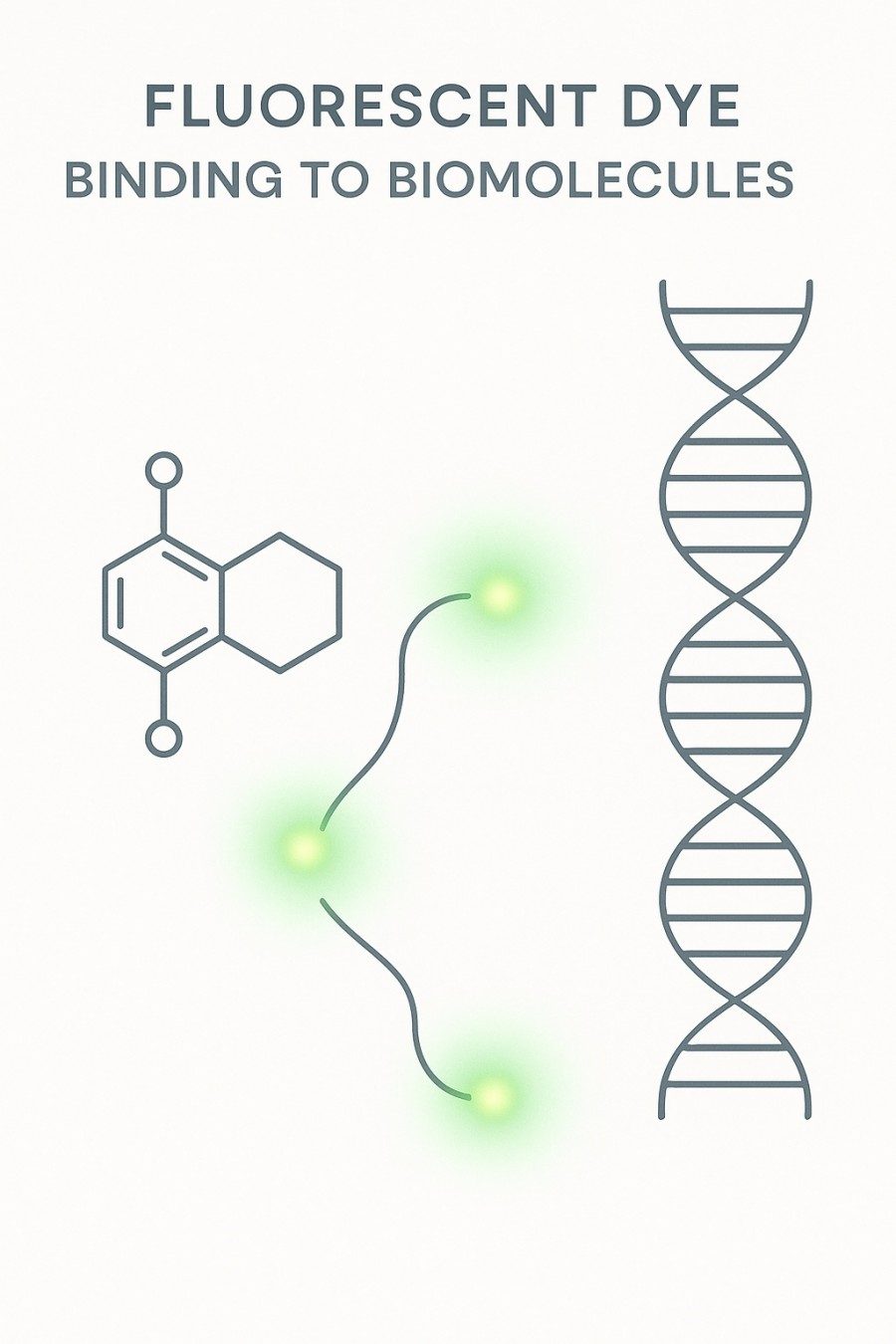Fluorescence Labeling
High-PrecisionNext-Level Fluorescent BioconjugationAdvanced Fluorescent Labeling Technologies
Accelerate breakthroughs with high-performance fluorescent labeling services engineered for organizations at the forefront of biotechnology, pharmaceuticals, diagnostics, and contract research. Built on state-of-the-art conjugation chemistry, optimized reaction systems, and strict quality control, our solutions deliver fluorescently labeled biomolecules with exceptional brightness, superior stability, and industry-leading reproducibility. From antibodies, proteins, peptides, and nucleic acids to lipids, nanoparticles, and small-molecule probes, we provide fully customized fluorescent labeling tailored to diverse research applications. Whether you are developing next-generation therapeutics, advancing diagnostic platforms, conducting cell imaging or molecular biology studies, or running high-throughput screening, our labeled biomolecules ensure the strongest signal integrity, minimal background, and consistent performance across experiments.
Choose from single-fluorophore labeling, multiplex fluorescent panels, or custom fluorophore integration designed for even the most demanding workflows. Every conjugate is engineered for maximum sensitivity, exceptional photostability, and reliable batch-to-batch consistency, empowering your team to generate confident, publication-quality results and streamline your research pipeline.
What Is Fluorescent Labeling?
Fluorescent labeling enables researchers to track, visualize, and quantify biomolecules using dyes that emit light upon excitation. By conjugating fluorophores to antibodies, proteins, peptides, nucleic acids, lipids, or small molecules, our service supports applications ranging from cell imaging and flow cytometry to HTS, mechanism studies, diagnostics, and drug-target interaction analysis. We specialize in custom, highly controlled labeling, ensuring your biomolecule maintains its bioactivity, purity, and specificity after conjugation.

What Problems We Solve
We improve fluorescence intensity with optimized dye selection and controlled dye-to-molecule ratios, ensuring bright and reliable signal output.
Our gentle, application-matched conjugation methods preserve protein, nucleic acid, and small-molecule functionality during the labeling process.
Free dye and impurities are removed through advanced purification, resulting in clean, low-noise fluorescence for imaging and quantitative assays.
We design multi-color panels with precise spectral spacing to prevent signal interference and improve accuracy in flow cytometry and microscopy.
Photostable dyes, optimized buffers, and controlled reaction conditions ensure strong signal retention and resistance to photobleaching.
We successfully label challenging molecules—including hydrophobic drugs, lipids, oligos, and nanoparticles—where standard methods often fail.
Our Fluorescent Labeling Services
We provide a complete portfolio of custom fluorescent labeling services, covering biomolecules, nucleic acids, nanoparticles, lipids, enzymes, and specialty compounds. Each project is supported by precision chemistry, optimized conjugation strategies, and high-purity purification workflows to ensure exceptional brightness, stability, and biological integrity.
 Fluorescence Labeling of Antibodies
Fluorescence Labeling of Antibodies
Capabilities include:
- Site-specific or random labeling via amine, thiol, glycan, or Fc-preserving chemistries
- Controlled DAR (Degree of Labeling) optimization for consistent fluorescence performance
- Compatible with IgG, IgM, IgA, Fab fragments, scFv
- Specialized low-aggregation labeling ideal for flow cytometry, IHC, immunofluorescence
- Buffer exchange and format optimization (PBS, Tris-free, BSA-free, azide-free)
- Multi-color/multi-panel antibody labeling with spectral overlap minimization
- High-purity conjugates prepared by SEC, desalting columns, or affinity cleanup
- Fluorescent labeling compatible with diagnostic assay development
- Low-endotoxin antibody preparations for sensitive cellular applications
- Full QC panel including absorbance ratio, SDS-PAGE, fluorescence spectra, DOL, and optional binding activity testing
Popular dyes:
FITC, PE, APC, Alexa Fluor, Cy3, Cy5, Cy7, FAM, TRITC
 Fluorescence Labeling of Proteins & Enzymes
Fluorescence Labeling of Proteins & Enzymes
Capabilities include:
- Covalent conjugation using NHS esters, maleimide-thiol coupling, click chemistry (SPAAC, DBCO, TCO)
- Labeling for soluble proteins, membrane proteins, enzyme complexes, and fusion proteins
- Custom strategies to avoid active-site masking and maintain enzymatic function
- Labeling densities adjustable for kinetic assays, fluorescence polarization, and biosensor applications
- High-stability labeling for long-term imaging and high-intensity laser exposure
- Purification via size-exclusion chromatography, HPLC, or ultrafiltration
- QC support including intact mass verification, SDS-PAGE, fluorescence scan
- Compatibility with FRET, FLIM, BLI, SPR, and high-throughput screening
- Large-scale protein labeling for industrial research or assay kit production
- Formulation development to improve solubility, reduce aggregation, and enhance stability
Popular dyes:
Alexa Fluor, FITC, TAMRA, TRITC, Cy3, Cy5, Bodipy, ATTO dyes, NIR dyes
 Fluorescence Labeling of Peptides & D-Amino Acids
Fluorescence Labeling of Peptides & D-Amino Acids
Capabilities include:
- N-terminal, C-terminal, or internal site labeling with FAM, TAMRA, Cy dyes, Bodipy, etc.
- Labeling compatible with linear peptides, cyclic peptides, disulfide-rich peptides, and stapled peptides
- Custom linker/spacer engineering (C2–C12, PEGylated linkers) to reduce quenching
- Ideal for receptor-binding assays, uptake studies, protease substrate studies
- Purification via HPLC with >90–98% purity options
- Fluorescent peptide libraries for screening and SAR studies
- Labeling of D-amino acid–containing peptides for cell wall labeling or metabolic tracking
- Dye-to-peptide ratio optimization for enhanced fluorescence readouts
- High solubility formulations suitable for cell-based assays
- Optional modifications: acetylation, amidation, PEGylation, lipidation
Popular dyes:
FAM, TAMRA, ROX, Cy3, Cy5, Bodipy, Rhodamine, Alexa Fluor
 Fluorescence Labeling of Nucleic Acids
Fluorescence Labeling of Nucleic Acids
(DNA, RNA, siRNA, Oligos, dNTPs)
Capabilities include:
- 5', 3', or internal labeling of DNA, RNA, siRNA, miRNA, and aptamers
- Synthesis and labeling of fluorescent dNTPs, dUTP, ddNTPs, and modified nucleotides
- Production of FAM-labeled siRNA, Cy5-labeled oligos, and dual-labeled qPCR probes
- Custom quencher + reporter combinations for FRET and molecular beacons
- High-purity HPLC/PAGE purification and mass confirmation
- Integration of spacers (C6, C12, PEG linkers) for improved hybridization performance
- Labeling optimized for cellular uptake, trafficking, and live-cell RNA imaging
- Validated compatibility with qPCR, NGS library prep, hybridization assays, in vivo tracking
- Custom duplex, hairpin, or modified backbone support (LNA, 2'-OMe, phosphorothioate)
- High-stability fluorophores for long-term imaging and low background noise
Popular dyes:
FAM, HEX, ROX, Cy3, Cy5, ATTO dyes, Alexa Fluor
 Fluorescent Labeling of Small Molecules
Fluorescent Labeling of Small Molecules
Capabilities include:
- Covalent labeling of small-molecule drugs, fragments, scaffolds, metabolites, and chemical probes
- Multiple chemistries supported: NHS esters, maleimide, click chemistry (SPAAC, DBCO, TCO–tetrazine), sulfonyl chlorides
- Labeling compatible with hydrophobic, charged, and aromatic-rich compounds
- Custom linker insertion to tune solubility, permeability, and reduce steric hindrance
- Purification using HPLC, prep-HPLC, or flash chromatography with >95% purity
- Ideal for target engagement assays, HTS, fluorescence polarization, and binding kinetics
- Custom fluorophore integration for FRET probes, biosensor probes, and enzyme substrates
- Mass-spec validated products with optional NMR confirmation
- Optimization for in-cell or in vivo imaging of small-molecule behavior
- Formulation support for DMSO-based stocks or aqueous-compatible delivery
Popular dyes:
FAM, TAMRA, Cy3/Cy5, Bodipy, Rhodamine, Alexa Fluor
 Fluorescent Labeling of Lipids & Phospholipids
Fluorescent Labeling of Lipids & Phospholipids
Capabilities include:
- Labeling of phospholipids, glycolipids, sphingolipids, cholesterol derivatives, and lipid analogs
- Incorporation of membrane-compatible fluorophores such as BODIPY, NBD, DiI, DiO, ATTO dyes
- Covalent attachment or membrane insertion labeling depending on research needs
- Dyes optimized for membrane dynamics, lipid trafficking, endocytosis, and exocytosis studies
- Support for custom phospholipid headgroup modifications (amine, carboxyl, PEG spacer)
- Lipid-labeling strategies designed to retain bilayer stability and fusion properties
- Purification via HPLC and verification of dye incorporation efficiency
- Suitable for both live-cell and fixed-cell membrane imaging
- Customizable dye loading levels for quantitative lipid visualization
- High-stability formulations compatible with surfactants, vesicles, and solvent systems
Popular dyes:
Bodipy FL, Bodipy 500/510, DiI, DiO, FITC-lipid analogs, Alexa Fluor
 Fluorescent Liposomes & Lipid-Based Nanostructures
Fluorescent Liposomes & Lipid-Based Nanostructures
Capabilities include:
- Preparation of fluorescently labeled liposomes via bilayer insertion, covalent lipid labeling, or encapsulation strategies
- Customizable liposome sizes (50–400 nm) via extrusion or microfluidic assembly
- Suitable for neutral, cationic, anionic, and PEGylated liposomes
- Multi-color liposome labeling for tracking fusion, uptake, biodistribution, and drug release
- Compatible with cellular delivery studies, in vivo imaging, and nanomedicine R&D
- Encapsulation of fluorescent probes for drug release kinetics or payload tracking
- High colloidal stability formulations for serum-containing media
- Purification using size-exclusion chromatography for high-purity liposomes
- Available surface functionalization (antibody, peptide, aptamer) for targeted delivery
- QC including DLS sizing, zeta potential, fluorescence intensity, and encapsulation efficiency
Popular dyes:
DiI, DiO, DiD, Bodipy, Cy5, Cy7, NIR fluorescent dyes
 Fluorescent Labeling of Nanoparticles
Fluorescent Labeling of Nanoparticles
(Gold, Magnetic, Polymeric)
Capabilities include:
- Fluorescent labeling of gold nanoparticles, iron oxide nanoparticles, polymeric nanoparticles, silica NPs, and quantum dots
- Surface modification (COOH, NH2, SH, PEG) prior to dye conjugation
- Labeling compatible with in vivo imaging, biodistribution tracking, and cellular uptake studies
- Stable dye integration that resists photobleaching and surface dissociation
- Customizable particle sizes from 10 nm to 500 nm
- Multi-color nanoparticle labeling for multiplex tracking
- Ligand co-functionalization (antibodies, peptides, aptamers) optional
- QC including DLS, zeta potential, fluorescence spectra, and TEM (optional)
- Formulations for high colloidal stability in buffers and serum
- Suitable for nanomedicine, targeted delivery, and theranostic research
Popular dyes:
FITC, Rhodamine, Cy5, Cy7, Alexa Fluor
 Fluorescent Microspheres & Bead-Based Conjugates
Fluorescent Microspheres & Bead-Based Conjugates
Capabilities include:
- Fluorescent labeling of polystyrene, silica, and magnetic microspheres
- Surface chemistries supported: COOH, NH2, epoxy, aldehyde, streptavidin-coated beads
- Custom dye loading for bright, uniform fluorescence in assay development
- Multi-color bead production for multiplex diagnostic assays
- Covalent attachment of proteins, antibodies, or peptides to fluorescent beads
- Support for bead sizes from 100 nm to 20 µm
- Ideal for flow cytometry calibration, immunoassays, and cell sorting applications
- Fluorescent bead stabilization for long-term storage without signal decay
- QC including fluorescence uniformity, particle size distribution, and binding efficiency
Popular dyes:
FITC, PE, Cy3, Cy5, Alexa Fluor, NIR dyes
 Fluorescent Labeling of Carbohydrates & Polysaccharides
Fluorescent Labeling of Carbohydrates & Polysaccharides
Capabilities include:
- Fluorescent labeling of glycans, polysaccharides, glycoproteins, and carbohydrate derivatives
- Hydrazide/aldehyde, amine-reactive, or click-chemistry–based conjugation
- Labeling compatible with branched polysaccharides and complex glycan libraries
- Ideal for studying glycan–protein interactions and cell-surface sugar dynamics
- High-purity conjugates via chromatographic cleanup
- Custom linkers to preserve carbohydrate structure and flexibility
- Compatibility with lectin binding studies, glycomics, and immune recognition assays
- Labeling for in vivo carbohydrate uptake tracking
- Spectrally distinct fluorophore options for multi-glycan assays
- Stability-optimized formulations for long-term storage and repeated use
Popular dyes:
FITC, TRITC, Alexa Fluor dyes, Bodipy
 Fluorescent Labeling of Fatty Acids & Metabolic Tracers
Fluorescent Labeling of Fatty Acids & Metabolic Tracers
Capabilities include:
- Labeling of fatty acids (C6–C20), metabolic tracers, and β-oxidation substrates
- Integration of BODIPY, NBD, or custom NIR dyes for metabolic imaging
- Suitable for studies of fatty acid uptake, transport, oxidation, and lipid turnover
- Custom linker lengths to retain native fatty acid biological behavior
- High-purity products (>95%) via HPLC purification
- Format optimization for serum-containing conditions or cell-based uptake assays
- Labeling strategies designed for lipid droplet imaging and membrane incorporation
- Compatible with in vivo metabolic flux analysis
- Stability-enhanced formulations to prevent oxidation or degradation
- Fluorescence quantification validated for metabolic assays or high-throughput screening
Popular dyes:
Bodipy FL C12, Bodipy C16, Rhodamine-based dyes
 Fluorescent Streptavidin Conjugation
Fluorescent Streptavidin Conjugation
Capabilities include:
- Fluorescent labeling of streptavidin, neutravidin, and avidin
- Conjugation to a broad spectrum of fluorophores (FITC, PE, Cy5, Alexa Fluor series, NIR dyes)
- Preserved biotin-binding capacity after labeling through controlled reaction conditions
- Ideal for ELISA, flow cytometry, biosensors, and immunoassays
- Multi-color streptavidin conjugates for multiplex biotin-binding assays
- Compatible with bead-based systems, nanoparticles, and surface-immobilized formats
- Purification by SEC to remove free dye and ensure high-purity conjugates
- Custom DOL tuning for optimal brightness with minimal steric hindrance
- QC includes fluorescence measurement, binding efficiency tests, and SDS-PAGE analysis
Popular dyes:
FITC, PE, APC, Cy3, Cy5, Alexa Fluor
Fluorophores We Offer
To support a wide range of research applications—from cell imaging and flow cytometry to qPCR, nanoparticle tracking, and high-throughput screening—we offer an extensive portfolio of high-performance fluorophores. Our selection includes standard fluorescent dyes, near-infrared probes, and specialized dye chemistries optimized for proteins, antibodies, peptides, nucleic acids, lipids, nanoparticles, and small molecules. Each fluorophore is chosen for its brightness, photostability, spectral clarity, and compatibility with modern detection platforms, enabling precise and reproducible fluorescence-based analysis across diverse scientific workflows.
| Fluorophore | Excitation (nm) | Emission (nm) | Applications | Features |
| FITC (Fluorescein Isothiocyanate) | 495 | 519 | Immunofluorescence, flow cytometry, IHC, Western Blot | High brightness, commonly used for antibody labeling |
| Alexa Fluor 488 | 495 | 519 | Microscopy, flow cytometry, protein labeling | Bright, photostable, ideal for multicolor panels |
| Cy3 | 550 | 570 | FACS, immunohistochemistry, real-time PCR | Bright emission, popular for protein and antibody labeling |
| Cy5 | 649 | 670 | DNA hybridization, fluorescence microscopy | Excellent for multiplex assays, low background |
| Cy7 | 749 | 776 | In vivo imaging, multiplexing, flow cytometry | Near-IR for deep tissue imaging, photostable |
| FITC-conjugated Antibodies | 495 | 519 | Flow cytometry, cell sorting, immunostaining | Popular for antibody conjugation in diagnostic assays |
| BODIPY | 503–505 | 510–525 | Membrane studies, lipid tracking, high-throughput assays | Lipophilic, ideal for lipid labeling and tracking |
| DiI (1,1'-Dioctadecyl-3,3,3',3'-Tetramethylindocarbocyanine) | 484 | 501 | Lipid bilayer studies, live-cell tracking | Bright red, excellent for membrane labeling |
| DiO (3,3'-Dioctadecyloxacarbocyanine Perchlorate) | 484 | 501 | Liposome and membrane studies, cellular uptake | Green fluorescence, widely used for lipid studies |
| Bodipy FL C12 | 503 | 513 | Fatty acid metabolism, lipid tracking | Hydrophobic, ideal for metabolic studies |
| Rhodamine B | 543 | 575 | Nucleic acid staining, fluorescence microscopy | Strong fluorescence, used for live-cell imaging |
| TAMRA (Tetramethylrhodamine) | 540 | 565 | Protein labeling, fluorescence polarization | Excellent for protein-protein interaction studies |
| Rox (Rhodamine X) | 586 | 607 | PCR, quantitative assays | Excellent for multiplexing and real-time PCR |
| NIR Dye 800 | 780 | 805 | In vivo imaging, multiplex assays, animal research | Ideal for deep tissue imaging, low auto-fluorescence |
| ATTO 488 | 498 | 523 | Fluorescence microscopy, FRET | High brightness, used for biomolecular interactions |
Our Labeling Chemistry & Methods
Achieving reliable and high-performance fluorescent labeling requires selecting the right conjugation strategy for each biomolecule. Our platform integrates a comprehensive suite of bioconjugation chemistries, enabling precise, efficient, and application-specific fluorescent labeling of antibodies, proteins, peptides, nucleic acids, lipids, polysaccharides, nanoparticles, and small molecules. By leveraging NHS ester coupling, maleimide–thiol reactions, click chemistry, enzymatic labeling systems, and advanced site-specific methodologies, we ensure optimal dye attachment, structural integrity, and functional preservation across all project types.
| Labeling Method | Chemistry | Common Applications | Advantages |
| NHS Ester (Amine Labeling) | Uses N-Hydroxysuccinimide (NHS) ester for covalent coupling to primary amines (e.g., lysines) on proteins or peptides. | Protein labeling, Antibody labeling, Peptide conjugation | Simple, robust, fast, and commonly used in protein conjugation |
| Maleimide (Cysteine Labeling) | Maleimide groups react with thiol groups (-SH) on cysteine residues, forming a stable thioether bond. | Protein modification, Antibody conjugation, Peptide labeling, Labeling cysteine-rich proteins | Highly specific to cysteine residues, minimal side reactions |
| Click Chemistry (Azide-Alkyne Reaction) | Uses azide and alkyne functional groups that undergo a catalyst-free, strain-promoted reaction. | Site-specific labeling of proteins, Peptide labeling, Fluorescent probe conjugation | Fast, high yield, allows site-specific labeling without disrupting protein function |
| Carbodiimide Chemistry (EDC/NHS) | Carbodiimides activate carboxyl groups on proteins or other biomolecules to form covalent amide bonds with amines. | Carbohydrate conjugation, Protein conjugation, Peptide labeling | Simple, efficient, mild conditions; commonly used for protein-carbohydrate conjugation |
| Sortase-Mediated Labeling | Sortase A enzyme catalyzes the attachment of a fluorophore to a sorting tag on proteins. | Site-specific protein labeling, Recombinant protein modification, Peptide tagging | Provides precise, controlled labeling with minimal modification of the protein's function |
| Enzyme-Catalyzed Labeling | Engineered enzymes selectively bind to fluorophore substrates and incorporate them into proteins. | Tagging proteins, Live-cell imaging, Protein localization studies | High specificity, non-invasive, suitable for live-cell imaging and protein tracking |
| Photo-Crosslinking Chemistry | Photo-reactive groups (e.g., aryl azides) are incorporated into proteins or peptides and activated under UV light to form covalent bonds with neighboring molecules. | Protein-protein interactions, Receptor-ligand binding studies, Cell signaling | Allows for precise localization of molecular interactions in cells or tissues |
| Fluorescent Dyes (Nucleophilic Substitution) | Fluorescent dyes (e.g., FAM, TAMRA, Cy5) are conjugated to nucleophilic groups (e.g., amino, thiol, or hydroxyl groups) on biomolecules. | General protein labeling, Nucleic acid labeling, Peptide modification | Provides versatile labeling with a broad range of commercially available fluorophores |
| Hydrazide/Carbonyl Chemistry | Hydrazides react with carbonyl groups on reducing sugars or aldehydes. | Glycoprotein labeling, Carbohydrate conjugation, Sugar modification | Effective for glycobiology and carbohydrate research |
| Succinimidyl Ester Chemistry | Succinimidyl esters react with primary amines to form stable amide bonds. | Antibody labeling, Protein conjugation, Peptide modification | Highly reactive, easy-to-use, common for bioconjugation of proteins and peptides |
Quality Control & Data Delivered
We provide a comprehensive QC package to ensure the accuracy, purity, and performance of every fluorescently labeled biomolecule. Each project is validated using industry-standard analytical methods, ensuring consistent reproducibility and reliable experimental results.
| QC Item | Description / Method | Delivered Data |
| Purity Analysis | HPLC / SEC / PAGE | Chromatograms, % purity |
| Dye–to–Molecule Ratio | UV-Vis spectral analysis | DOL / DAR values |
| Integrity Verification | SDS-PAGE / LC-MS | Gel images, mass confirmation |
| Fluorescence Characterization | Excitation/emission spectra | Spectral profiles |
| Binding/Activity Test (optional) | ELISA / functional assay | Activity confirmation |
| Size Distribution (for particles) | DLS / TEM | Size report, PDI |
| Stability Assessment | Fluorescence decay / storage stability | Stability data |
General Workflow for Fluorescence Labeling Services

We evaluate your target molecule, application requirements, and preferred fluorophores. A customized labeling strategy and chemistry selection are designed to ensure optimal performance.
Incoming samples are inspected, quantified, and buffer-exchanged if necessary. We remove interfering components to ensure efficient, high-yield conjugation.
Labeling is performed using optimized reaction conditions and controlled dye-to-molecule ratios. Both site-specific and conventional labeling strategies are available.
Excess dye is removed through SEC, HPLC, or ultrafiltration to achieve high-purity conjugates. Purification is tailored to the biomolecule type.
Each conjugate undergoes purity, DOL/DAR, spectral, and structural integrity analysis. Optional functional assays confirm biological activity when required.
You receive the labeled product with a complete QC report and handling guidelines. Our team provides follow-up consultation to ensure successful downstream application.
Advantages of Our Fluorescent Labeling Services
Our fluorescent labeling services deliver high sensitivity and specificity for even the most challenging biological samples, ensuring accurate detection of low-abundance biomolecules in complex matrices.
We offer fluorescent labeling for a wide range of biomolecules, including proteins, nucleic acids, lipids, small molecules, and nanoparticles, allowing you to address diverse research needs with a single provider.
With multicolor fluorescence and multiplexing capabilities, our services enable simultaneous detection of multiple targets in a single experiment, making us an ideal partner for high-throughput screening and multicolor imaging.

Benefit from high temporal and spatial resolution in your research, with real-time tracking of protein dynamics, gene expression, and cellular behavior, essential for studying fast biological processes.
Our fluorescent labeling technology enables precise and quantitative analysis of biomolecule concentrations and interactions, making it invaluable for accurate assay development and biomarker quantification.
We tailor our fluorescent labeling services to meet your unique research goals, including site-specific labeling, custom fluorophore selection, and highly specific conjugation methods that suit your exact requirements.
Applications of Fluorescent Labeling Technology
Imaging
- Visualize cellular structures, organelles, and protein localization using fluorescent probes.
- Track live-cell dynamics such as migration, division, apoptosis, and intracellular transport.
- Map spatial distribution of biomolecules with high-resolution fluorescence microscopy.
- Perform multi-color imaging to study complex biological interactions in real time.
Flow Cytometry
- Identify and quantify specific cell populations using fluorescent antibody panels.
- Perform multi-parameter immunophenotyping with minimal spectral overlap.
- Analyze cell viability, activation markers, and intracellular proteins with high sensitivity.
- Enable high-throughput cell sorting based on fluorescence intensity and biomarker expression.
Diagnostics
- Develop fluorescence-based assays for biomarker detection.
- Enhance qPCR and molecular diagnostic platforms with fluorescent probes and dNTPs.
- Improve sensitivity and specificity in immunoassays using labeled detection antibodies.
- Support point-of-care and high-throughput diagnostic systems with robust fluorescence readouts.
Molecular Biology
- Track DNA, RNA, and siRNA delivery, localization, and intracellular trafficking.
- Monitor nucleic acid hybridization efficiency using fluorescent probes.
- Study gene expression, replication, repair, and transcription dynamics with labeled nucleotides.
- Enable live-cell nucleic acid imaging with high-stability fluorophore-tagged constructs.
Drug Discovery
- Perform binding assays using fluorescently labeled small molecules, peptides, or receptors.
- Accelerate high-throughput screening with robust fluorescence-based readouts.
- Track compound uptake, biodistribution, and cellular trafficking in drug evaluation.
- Develop fluorescent probes for target validation and mechanism-of-action studies.
Nanotechnology
- Track nanoparticle uptake, distribution, and intracellular pathways using fluorescent labeling.
- Visualize nanocarrier behavior in live cells and animal models.
- Evaluate targeted delivery efficiency with fluorescence-tagged nanoparticles or liposomes.
- Support nanomedicine development through high-resolution fluorescence imaging.
Lipid & Membrane Studies
- Analyze membrane fluidity, domain organization, and lipid raft dynamics.
- Trace lipid metabolism and transport using fluorescent fatty acids and phospholipids.
- Visualize vesicle formation, fusion, and endocytic pathways.
- Investigate drug–membrane interactions using fluorescence-based assays.
Glycobiology
- Study glycan–protein interactions with fluorescently labeled carbohydrates.
- Visualize cell-surface glycan distribution in live or fixed samples.
- Track polysaccharide uptake, metabolism, and cellular processing.
- Develop fluorescent glycan probes for glycomics and immune recognition studies.
Case Study
- Case Study 1
The process of fluorescence labeling DNAs is critical yet the existing techniques tend to be costly and labor-intensive. We introduce a novel, efficient, and affordable method for fluorescence labeling of oligonucleotides using base excision trapping (BETr). This method utilizes deaminated DNA bases to identify label positions and aminooxy-substituted rotor dyes to highlight AP sites, leading to high emission intensities. Importantly, BETr can work in conjunction with DNA synthesis by polymerases, allowing for the integration of multiple uracil into an amplicon and in situ BETr labeling without any need for washing. Furthermore, BETr permits high labeling density of dsDNA such as genomic DNA in a single tube through nick translation. By using two different deaminated bases, two-color site-specific labeling is achieved. This methodology also utilizes a multi-labeled DNA construct as a luminescent tag, an added advantage demonstrated by linking to an antibody for protein imaging. The technique also leverages the double-strand selectivity of a repair enzyme in accurately detecting the presence of a target DNA or RNA in a mixed sample with isothermal turnover and single nucleotide specificity. Hence, BETr offers a highly adaptable and easy way for general fluorescence labeling of DNAs.
 Fig.2 In situ DNA synthesis and BETr labeling. (Jun, Y.W., 2022)
Fig.2 In situ DNA synthesis and BETr labeling. (Jun, Y.W., 2022)
- Case Study 2
The recent notable rise in the usage of deep eutectic solvents (DESs) offers novel methodologies for sample collection and preparation. However, utilizing these new solvents poses difficulties for subsequent analyses since standard analytical techniques, like fluorescence labeling, may be incompatible. This study investigates the efficacy of three conventional fluorescent labels in derivatizing amino acids in prevalent DESs, comprised of choline chloride and ethylene glycol. We found that the distinctive solvent attributes of the DESs permit two fluorophores, fluorescein isothiocyanate and 5-carboxyfluorescein succinimidyl ester, to successfully label amino acids. Conclusions indicate the feasibility of effectively labeling both D- and L-amino acids at concentrations as low as 4 μM in solution. Following this process, capillary electrophoretic separation is able to detect as low as 50 nM, without the need to eliminate any DES. This is the first time a total fluorescent labeling reaction has been carried out in a DES, followed by capillary electrophoretic separation of the analytes.
 Fig.3 Representative electropherograms of various amino acids simultaneously reacted in 5 mM KOH ethaline at (1) Leu, (2) L-His, (3) L-Ser, (4) L-Ala, (5) Gly, and (6) L-Glu, all at 25 μM amino acid with FITC. (2. Torres, J., 2022)
Fig.3 Representative electropherograms of various amino acids simultaneously reacted in 5 mM KOH ethaline at (1) Leu, (2) L-His, (3) L-Ser, (4) L-Ala, (5) Gly, and (6) L-Glu, all at 25 μM amino acid with FITC. (2. Torres, J., 2022)
Frequently Asked Questions (FAQ)
Fluorescence labeling is a technique used in biological and medical research to tag or highlight specific proteins, cells, or other molecules of interest. This is achieved by attaching fluorescent dyes or proteins to the target molecules, which emits light of a longer wavelength when excited by light of a shorter.
The process of fluorescence labeling involves attaching fluorescent dyes or proteins to the target molecules. Once these molecules are subjected to light of a certain wavelength, they absorb the light energy and re-emit it as light of a longer wavelength, producing a glow that can be detected and analyzed.
Fluorescence labeling of DNA is a technique used in molecular biology where fluorescent dyes are attached to DNA molecules. These labeled DNA fragments can then be visualized under a microscope or in an analytical instrument through the generation of a fluorescent signal. This method is commonly used in various DNA tests and experiments including gene mapping, DNA sequencing, DNA microarrays, and studies involving gene expression and regulation.
It works on the principle that certain chemicals, known as fluorescent dyes, can intercalate (slot between) the bases (A, T, C, G) of DNA. When these dyes are exposed to a specific wavelength of light, they absorb the energy and enter into an excited state. After a short period, they drop back down to their normal energy state and give off a photon - this is the fluorescence that can be detected.
This technique allows for the visualization and analysis of specific biological substances in a much clearer and more detailed manner than traditional methods. It aids in studying cellular processes, protein-protein interactions and the distribution of molecules within cells. It is highly sensitive, precise, and can be used in live cells and organisms.
Fluorescence labeling can be utilized in many biological and medical research fields. This encompasses cell biology, microbiology, immunology, genetics, biochemistry, and more. They are frequently used in diagnostic assays, drug discovery and development, as well as in medical imaging procedures.
The main challenge of fluorescence labeling is to introduce the fluorescent label without interfering with the function of the molecule or system of interest. Some fluorescent tags can induce harmful effects when exposed to light, potentially causing cellular damage. Therefore, careful calibration and handling procedures are crucial in the use of this technique.
The cost of fluorescence labeling service can vary greatly depending on the type and amount of material to be labeled, the complexity of the procedure, and the specific fluorescent label used. Please contact us directly for a more specific and accurate quotation.
What Our Research Clients Say

"Their expertise in fluorophore selection and conjugation chemistry saved us substantial optimization time. The fluorescent nucleotides integrated perfectly into our workflows."
— Dr. M., Head of Technology, UK-based Biotechnology Company
"Their custom fluorescent oligo labeling performed flawlessly in our diagnostic assay development. Outstanding brightness with minimal background noise."
— Ms. Y., Senior Molecular Scientist, European Diagnostics Manufacturer
"The fluorescent liposome and nanoparticle conjugates significantly improved our in vivo imaging performance. Excellent reproducibility across batches."
— Dr. Z., Principal Researcher, Asia-Pacific Nanomedicine Startup
Custom Fluorescent Labeling Solutions for Every Research Need
No matter what your research requires—whether it's fluorescent nanoparticles, RNA studies, or enzymatic assays—we provide customized fluorescent labeling that fits your specific needs. Our team of experts is here to guide you through every step of the process, from dye selection to conjugation strategy, ensuring that your research is both successful and reproducible. Reach out to us for a quote or consultation, and let us help you with the ideal fluorescent labeling solution tailored to your research needs.